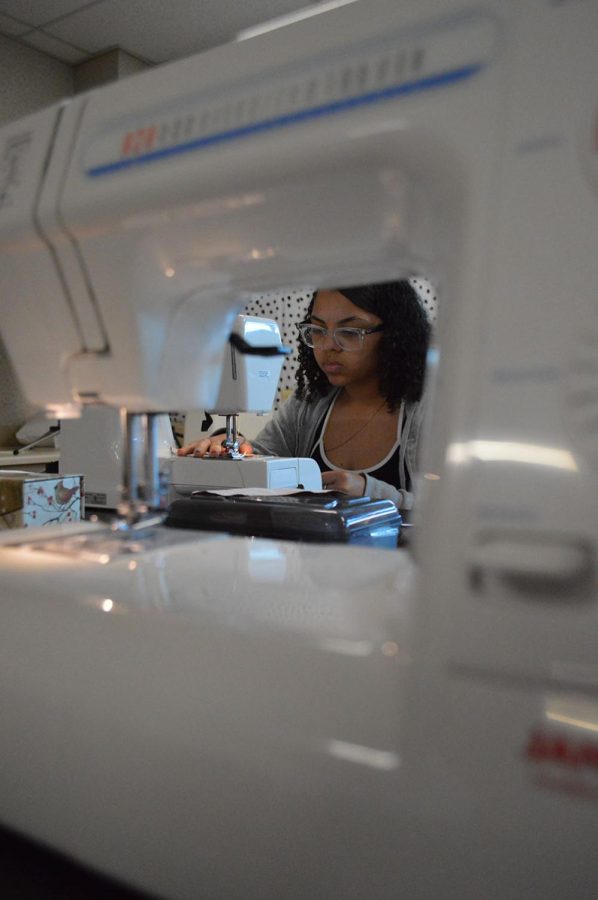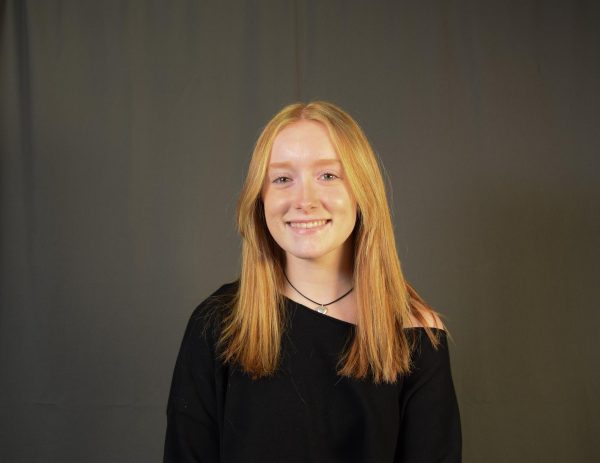Trash to treasure: upcycling becomes a popular and sustainable new way for students to spice up their wardrobes
NHS sophomore in McCann’s fashion class sews a clothing item. McCann’s students create unique sorts of clothes for the class.
May 27, 2022
In this new age of awareness of the environmental state, people are recognizing ways to combat overconsumption, and really give their all to the movement of Reduce, Reuse, and Recycle.
Hannah McCann, a fashion teacher here at NHS, introduces the idea of creating new pieces through an upcycling final that she has her students participate in that requires them to find things they already own and make it better.
“They’re pretty much tasked with going through their closet, going to Goodwill, finding something that they wouldn’t necessarily use, and then they get to redesign it and create it into something new that they actually would wear,” McCann said.
McCann took an intro-to-fashion class during her high school career before she graduated in 2016, and participated in the same project that she has her students completing today. She encourages her students to start small.
“Look in your own closet first,” said McCann. “I think you’d be surprised what you already have.”
McCann acknowledges that her students may not have all the necessities at home to create their own garments from scratch, but she hopes that her students are encouraged to recreate already existing pieces.
“Knowing how to recycle them and fix them and make them into cool things that they would like nowadays — especially just cause we’ve seen such an influx with fast fashion,” said McCann.
Fast fashion, defined by Oxford Language, is inexpensive clothing produced rapidly by mass market retailers in response to the latest trends. Places like Shien, Zara, Forever 21, and Urban Outfitters are all examples of fast fashion, and some of the top contributors to waste. Not only is upcycling becoming a hit thing in the fashion department here at NHS, but students outside of school such as Freshman Jaysa Richeson are putting the reuse in the mantra, reduce, reuse, recycle.
“When I’m upcycling, it’s kind of like I’m in my own calm state because I don’t have to think much about it,” says Richeson. “It makes me happy too — to know that I’m helping the environment and not just throwing something away that could be useful. It’s a good feeling.”
Richeson makes a plethora of wearable jewelry out of knick-knack items that she finds around her home, from little keys to little beads, she is finding a purpose for small and often forgotten items.
“I’d see an item and think, ‘How would that look as a necklace or an earring?” says Richeson.
Upcycling is not a new practice to Richeson, as memories of her mother creating items sparked a similar interest in upcycling.
“My mom would make these twince adjustable strap-things by hand and she’d sell them, and I always thought that was pretty cool,” Richeson said.
Reduce, reuse, and finally recycle. The concept of recycling at first glance can seem to be a fairly general concept, but recycling looks different around the world, and Hamilton county resident Richard Hooker experienced that first hand.
“We lived in Europe for a year and everything is recycled there,” Hooker said.
As Hooker stands on his porch, he talks about how Europe organizes their waste, a complex yet organized system in order to insure everything goes where it needs to go.
“You have yellow bags for plastics and wax covered things, then you have clean paper, cardboard and things like that, and then in every neighborhood there are bins for white glass, brown glass, and green glass,” Hooker said.
After experiencing recycling systems both here in the United States and Europe, Hooker stands with Europe’s way of going about consumer waste.
“I think it’s the responsible way to deal with things we use and consume and it’s best for the environment,” said Hooker. “I wish we did more with it. I think we can be conscious of the items we buy and that end up being thrown away.”
But for some, recycling isn’t as much of an easy process. Casey Porter, a resident in Hamilton County, explains why.
“Sometimes it’s more difficult to [recycle] than throw it in the trash,” says Porter. “They don’t make it very convenient, I feel like.”
Regardless of the difficulty, Porter still has a sense of awareness when it comes to recycling.
“I pay attention to things that can be recycled and can’t be,” Porter says.
When asking Dawn Westland, another resident in Hamilton county, she explains why she believes that recycling is important.
“Your grandchildren’s future,” says Westland. “Kinda what it comes down to.”





